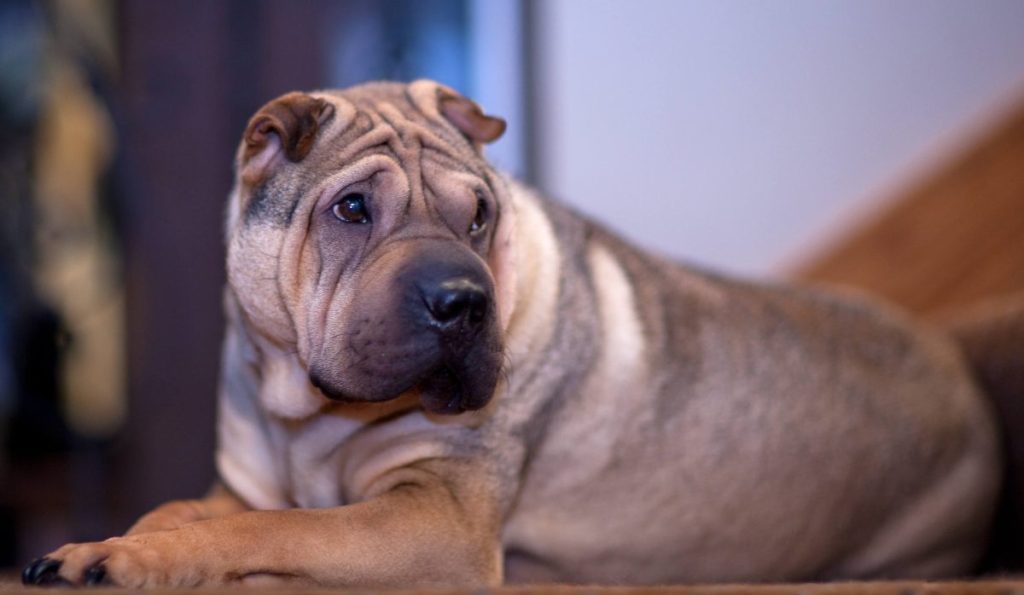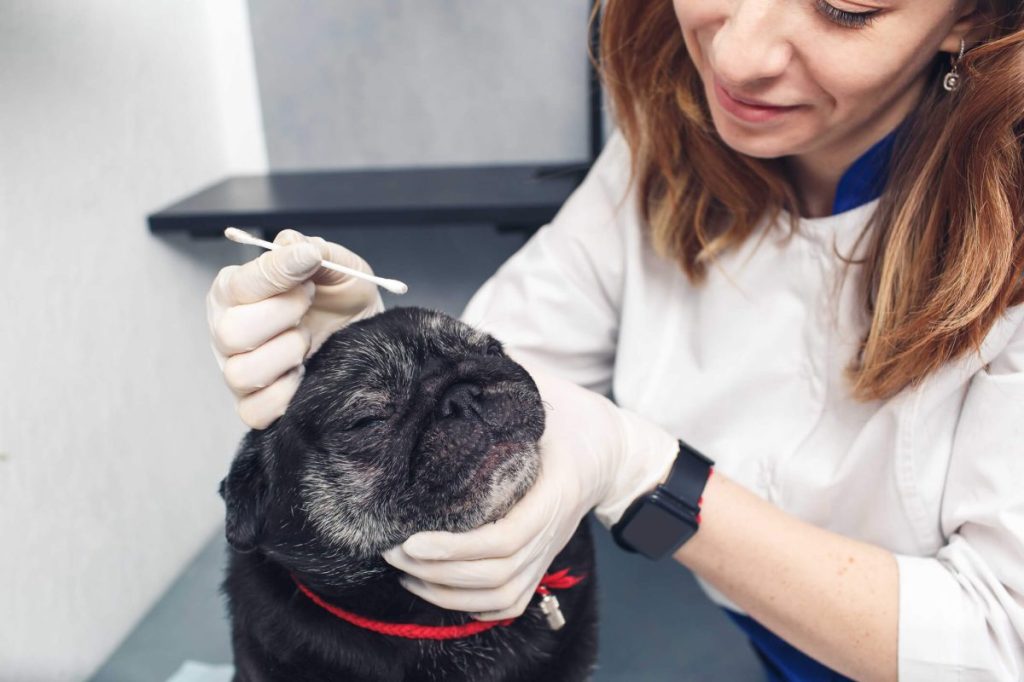Skin fold dermatitis, also known as intertrigo, is a common inflammatory condition that affects dogs with excessive skin folds. It occurs when the skin in these areas becomes irritated and infected due to the accumulation of moisture, heat, bacteria, and other pathogens. The condition is often manageable with appropriate topical treatments, although it may require ongoing care to prevent recurrence.
Here’s what you should know about the types, symptoms, causes, and treatments for the condition in dogs.
Types of skin fold dermatitis in dogs

There are several types of skin fold dermatitis that occur in various locations on a dog’s body, depending on their anatomy and breed characteristics. Here are the most common types:
Facial fold dermatitis
Facial fold dermatitis primarily affects the folds around a dog’s nose and eyes. It is especially common in brachycephalic breeds such as Bulldogs, Pugs, and Shih Tzus, which have distinctive wrinkles and loose skin around their muzzles and eyes. The constant moisture from tears and saliva, combined with limited airflow, makes these areas highly susceptible to infection and irritation.
Tail fold dermatitis
Breeds with corkscrew tails or tightly curled tails, like English Bulldogs, French Bulldogs, and Boston Terriers, often experience tail fold dermatitis. The folds beneath the tail can become a breeding ground for bacteria and yeast, especially if the area is not kept clean and dry.
Vulvar fold dermatitis
Vulvar fold dermatitis is seen in female dogs with recessed vulvas or excessive skin folds around their genital area. This can occur in overweight dogs and certain breeds predisposed to having excess skin. The folds can trap urine and moisture, leading to bacterial infections and skin irritation.
Body fold dermatitis
Body fold dermatitis can affect any dog with excessive skin folds. However, breeds like Shar-Peis and obese dogs are particularly susceptible to this type of intertrigo. These folds — particularly in the neck, chest, and armpit areas — can collect sweat, dirt, and bacteria.
Lip fold dermatitis
Lip fold dermatitis is prevalent in breeds with loose, droopy lips, such as Spaniels, Saint Bernards, and Bloodhounds. Food debris, saliva, and moisture can accumulate in these folds, leading to infection.
Symptoms of skin fold dermatitis in dogs
Dogs suffering from skin fold dermatitis typically exhibit several clinical symptoms, which can vary based on the severity and location of the condition. Common signs of intertrigo include:
- Redness and swelling within the folds
- Foul odor emanating from the infected area
- Itching and discomfort
- Crusty or scaly skin
- Discharge or pus (in severe cases)
- Lesions and sores
- Hair loss around the affected area
Causes of skin fold dermatitis in dogs
Intertrigo primarily occurs due to a combination of mechanical friction, trapped moisture, and limited air circulation within skin folds. This environment disrupts the skin’s natural barrier function, leading to:
- Macroscopic trauma: Constant rubbing of skin against skin causes minor abrasions and irritation.
- Moisture retention: Sweat, oils, and other secretions become trapped within the folds, creating a warm, humid environment ideal for microbial growth.
- pH Imbalance: Moisture and trapped secretions can alter the pH of the skin, encouraging the growth of pathogenic bacteria and fungi, particularly Malassezia yeast.
- Microbial proliferation: The disrupted skin barrier and altered pH facilitate the growth of bacteria such as Staphylococcus pseudintermedius and Streptococcus spp., as well as yeasts, resulting in infection and inflammation.
Other contributing factors include obesity — which exacerbates the depth and friction of skin folds — as well as poor hygiene, which allows sweat, dirt, and other debris to accumulate in these areas. Additionally, underlying conditions such as allergies, hormonal imbalances, or immune system disorders can trigger skin fold dermatitis. For instance, allergies can lead to excessive scratching and licking, further irritating the skin folds. Similarly, hormonal issues, such as hypothyroidism or Cushing’s disease, may alter the skin’s natural defenses, making it more susceptible to infections.
Treatments for skin fold dermatitis in dogs

If you suspect your dog might have skin fold dermatitis, take them to the vet immediately for a proper diagnosis. Your vet will perform a thorough physical examination, focusing on the skin folds, to look for signs of inflammation, infection, or other abnormalities. They might also take skin scrapings or swabs to analyze under a microscope, which helps identify any bacteria, yeast, or parasites present. In some cases, additional tests like cytology or culture and sensitivity tests may be recommended to pinpoint the exact cause of the infection.
After your dog is diagnosed, your vet may prescribe treatments tailored to their specific case of intertrigo. The primary goals are to reduce inflammation, control microbial overgrowth, and relieve symptoms. Potential management strategies include:
- Regular cleaning: Use a gentle, dog-safe cleanser and soft cloth or cotton pads to clean between the folds daily. Make sure you dry the folds thoroughly after cleaning, as moisture can exacerbate the condition.
- Medicated wipes and solutions: For more persistent cases, medicated wipes or solutions containing antiseptics like chlorhexidine or benzoyl peroxide can be very effective.
- Topical treatments: If your dog’s skin is already inflamed, your veterinarian may recommend topical treatments such as antibiotic ointments — e.g., mupirocin — or antifungal creams — e.g., ketoconazole.
- Surgical intervention: In extreme or recurrent cases, surgical correction of the skin folds — e.g., blepharoplasty for facial folds, tail fold resection — may be necessary to permanently eliminate the problematic areas.
With appropriate treatment and management, the prognosis for dogs with skin fold dermatitis is generally good. However, given the chronic and recurrent nature of the condition, long-term maintenance is often required to prevent flare-ups. As such, regular veterinary checkups and consistent home care routines play a vital role in ensuring the well-being of affected dogs.









